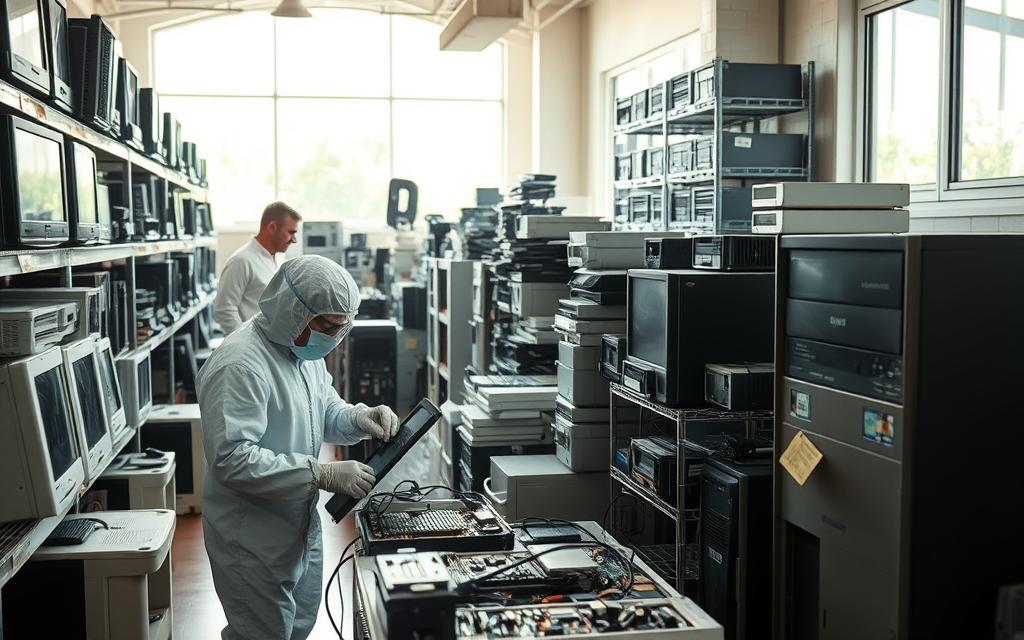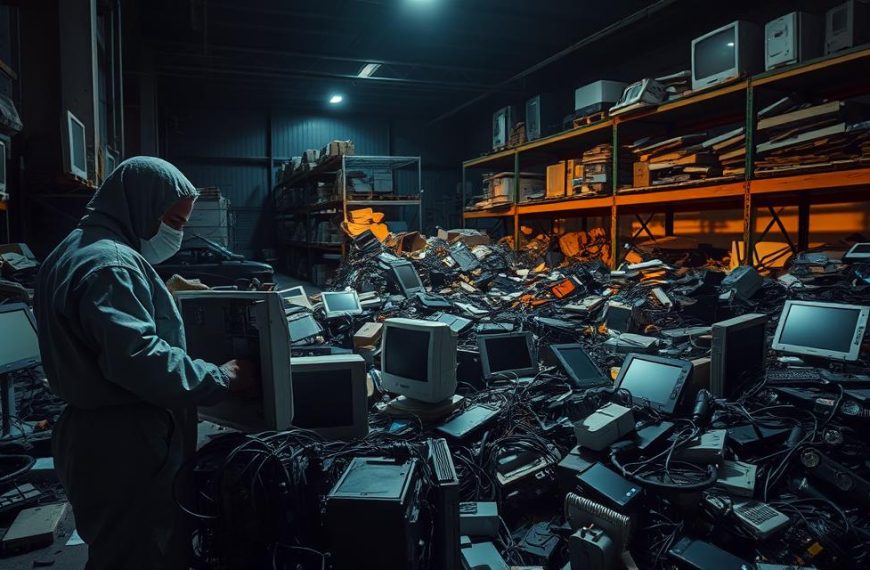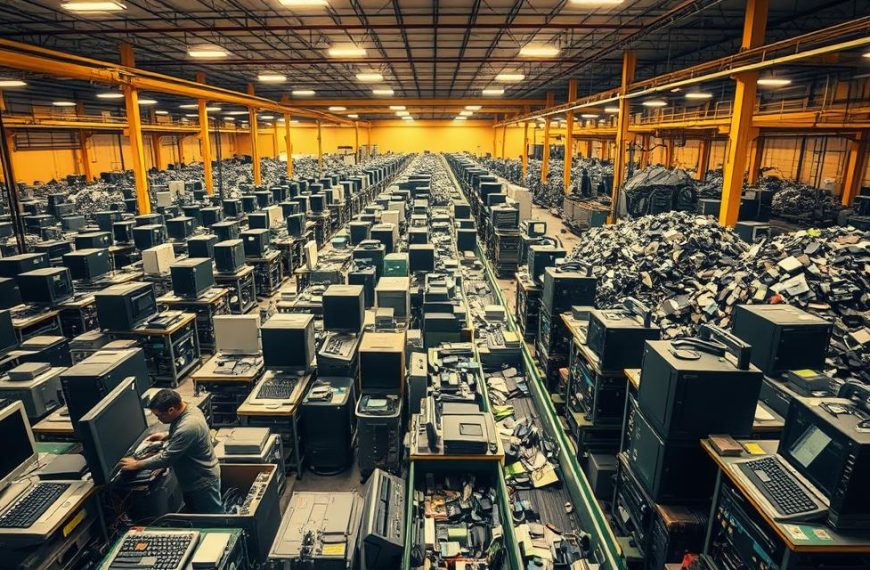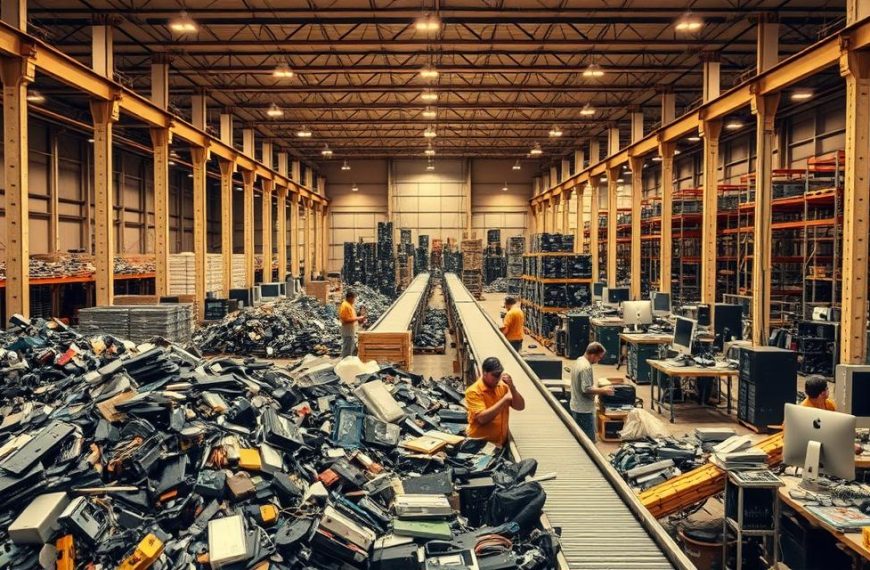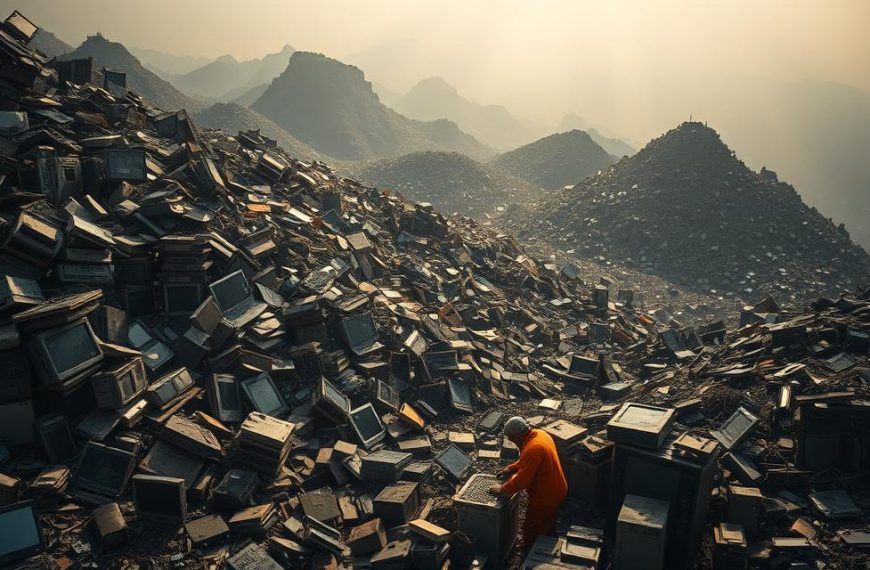When your computer is no longer useful, it’s important to dispose of it properly. Just throwing it away can harm the environment and pose security risks.
Electronic waste, or e-waste, contains harmful materials. If not disposed of correctly, it can pollute our soil and water. Proper computer disposal prevents this.
Your old computer might also hold personal data. Electronic recycling that erases all data is key to keeping your information safe from theft.
This guide will show you how to handle your old PC responsibly. We’ll cover data security, donating your computer, manufacturer programmes, and recycling centres. You’ll learn how to manage e-waste effectively.
Why Responsible Computer Disposal Matters
Getting rid of your old computer is more than just clearing space. It’s about protecting our planet and keeping your personal info safe from harm.
Old computers have hazardous materials that can harm the environment. If they’re not disposed of right, lead, mercury, and cadmium can pollute soil and water.
“Electronics should never be put in the Blue Bin (recycling) or garbage… ensured they are disposed of safely, recycled and kept out of landfill.”
Recycling computers properly helps save resources. Valuable metals like gold and silver, and plastics, can be reused.
Data security is also key. If your personal info isn’t wiped clean, it could lead to identity theft and fraud.
Professional services can erase all data on your device. They use special methods to make sure your info is gone for good.
The table below shows what’s in computers and how it affects the environment:
| Component | Hazardous Material | Environmental Risk | Recycling Potencial |
|---|---|---|---|
| Motherboard | Lead, mercury | Water contamination | Gold recovery |
| Battery | Cadmium, lithium | Soil pollution | Metal extraction |
| Monitor | Lead glass | Toxic leaching | Glass recycling |
| Hard drive | Rare earth metals | Landfill accumulation | Material reuse |
Landfill avoidance is a big reason for responsible computer disposal. It stops waste from taking up space and leaking toxins.
Using the right recycling channels helps avoid pollution. It also saves natural resources. This makes responsible disposal a must for everyone.
Choose certified recyclers who handle waste safely. They make sure harmful materials are dealt with right and resources are used wisely.
Backing Up and Securely Erasing Your Data
Before you give up your computer, it’s vital to protect your data. You need to save your files and remove all personal data from your device.
Step 1: Back Up Your Important Files
Creating a data backup is key to keeping your files safe. Windows and macOS both have built-in backup tools.
Windows users can use File History to save files to an external drive. Mac users have Time Machine for similar backups.
Cloud services like Google Drive, Dropbox, or OneDrive are also great for personal data protection. They let you access your files from any device with internet.
Step 2: Perform a Factory Reset or Use Erasure Tools
After backing up your files, it’s time to wipe your device. A factory reset brings your computer back to its original state. But, for extra security, you might need more steps.
For Windows systems (8.1, 10, and 11), go to Settings > Update & Security > Recovery. Then, select “Reset this PC” and choose “Remove everything” for a full wipe.
Mac users should start in Recovery Mode (Command + R during startup). Open Disk Utility, erase the hard drive, and then reinstall macOS. This makes sure the device is ready for the next user.
Tips for Effective Data Erasure
For really sensitive info, use data wiping software that goes beyond basic deletion. These tools write over data many times, making it hard to recover.
When resetting Windows, pick the “Fully clean the drive” option instead of “Just remove my files.” This does a deeper hard drive erase by overwriting all data sectors.
For top security, use tools like Disk Wipe or Active KillDisk. They offer military-grade wiping standards. These are best for business computers with confidential data.
Always check that the erasure is complete before recycling your device. This ensures your personal data protection is secure during disposal.
Donating Your Functional Computer
If your computer is working but you no longer need it, donating it is a great choice. It helps extend the life of the device and gives others access to technology they might not have.
Finding Organisations That Accept Donations
Many organisations accept functional electronics to help those in need. Schools, non-profits, and community centres often take in technology donations to support their work.
Groups like PCs for People focus on refurbishing and giving computers to those who can’t afford them. Local libraries, schools, and youth centres also accept donations for educational use.
| Organisation Type | Acceptance Criteria | Typical Recipients |
|---|---|---|
| National Charities | Working computers less than 8 years old | Low-income families, students |
| Local Schools | Educational software compatible devices | Classrooms, computer labs |
| Community Centres | Internet-ready systems | Job seekers, senior citizens |
| Non-profit Refurbishers | Repairable systems with original components | Charities, developing communities |
Preparing Your PC for Donation
Getting your computer ready for donation is key. It ensures it’s ready for its new owner. Start by wiping all data and then follow a few more steps.
First, clean the computer physically. Use compressed air for dust and a microfiber cloth for screens. Make sure all ports are clean and working.
Next, gather all original accessories. Include power cables, adapters, and any documentation. If you have installation media or software licenses, add those too. Systems with everything included are usually preferred.
Do a factory reset to start fresh. This removes your data and prepares the computer for someone else. Also, update the system to keep it secure.
Test the computer’s basics like internet, USB ports, and audio. A well-tested computer shows you care about your charity donation.
Organisations that refurbish PC equipment value well-prepared donations. Your efforts help make a real difference in your community.
Utilising Manufacturer Take-Back Programmes
Many computer makers now have take-back programmes. These make it easy to recycle old devices. They ensure old tech is disposed of right.
These schemes include safe data wiping and green recycling methods. They help keep our planet clean.
Apple Recycling Programme
Apple has a top recycling programme. Their Apple Trade In lets you trade in old devices for new ones or recycling. It takes in many Apple products, no matter their age or state.
PCMag says, “The Apple Trade In programme lets you use your old device to help pay for a new one.” This makes it a great deal. You just need to get your device valued online, send it in for free, and Apple will erase your data.
Dell Reconnect and Other Brand Initiatives
Dell’s Reconnect works with Goodwill in the US for easy drop-offs. It takes any computer brand, not just Dell. They make sure everything is recycled or fixed up right.
Big names like HP, Lenovo, and Microsoft also have recycling plans. They offer free shipping labels and clear steps to follow. You can even get your device’s value checked online.
Always check the recycling and data safety policies of any programme. These are great ways to recycle your old computer. You might even get something back for it.
Retailer Recycling Services in the US
In the US, big retail chains make it easy to recycle old electronics. They have many locations and clear rules for what you can drop off. This means you can recycle lots of different devices easily.
PCMag says you can recycle at stores like Best Buy and Staples. This makes it simple for people to get rid of old tech without going to special centres.
Best Buy Electronics Recycling
Best Buy has a big recycling program in the US. They take in most electronics, no matter where you bought them. Their Best Buy recycle program covers computers, monitors, printers, and more.
Most items are free to recycle, but some have a fee. TVs and monitors cost money, but computers and laptops are free. Just take them to the customer service desk when the store is open.
Best Buy also lets you trade in working devices and offers free pickup for big items in some places. Their website has a list of what they accept and any costs.
Staples Tech Recycling Programme
Staples has a retailer drop-off program for recycling tech. They take in computers, tablets, printers, and office electronics. The Staples recycling service is available at most stores during business hours.
Staples charges for some items, like CRT monitors and TVs. But most computer parts and peripherals are free. They work with certified recyclers to make sure everything is handled right.
Staples sometimes has special recycling events with more items accepted and deals. You can check what your local store accepts online before you go.
Both Best Buy and Staples give you proof that your items were recycled. This makes it easy for millions of Americans to recycle their electronics.
Locating Certified E-Waste Recycling Facilities
When you can’t use manufacturer take-back programmes or retailer services, certified e-waste facilities are the best choice. These centres follow strict rules to handle electronic parts safely. They also protect your data during recycling.
How to Find a Certified Recycler
Finding a trusted recycling partner means checking their certifications. Look for R2 Certified or e-Stewards badges. These show they care about the environment and keep your data safe.
Start by looking at your local government’s website. Many have lists of approved recycling centres. Toronto’s waste management site suggests visiting the Resources Productivity & Recovery Authority web page for more locations.
Use national databases to find recyclers near you. Sites like Sustainable Electronics Recycling International (SERI) have directories of R2 Certified facilities. Just type in your zip code to find recyclers in your area.
Local offices can give you the latest info. Contact your town’s district office or environmental services department. They usually have lists of certified e-waste recyclers in your area.
What to Expect at an E-Waste Facility
Certified e-waste facilities follow set rules for safety and compliance. When you arrive, you’ll find a system for dropping off your items. Staff will help you unload. Some centres have drive-through services for big items like desktops.
They might ask for some details about your devices. This helps them keep records for environmental reports. You might need to fill out a form with information about your electronics.
At these facilities, you might see technicians sorting materials. They break down computers into parts like plastics, metals, and circuit boards. This careful sorting helps recycle more and harm less.
Good centres are open about their work. They might offer tours or explain how they recycle. Feel free to ask about data security and environmental protection.
Selling Your Computer for Parts or Repair
If your computer is outdated but parts are usable, selling it can be a smart move. It helps you get back some of what you spent and supports the environment by giving old parts a new life.
Platforms for Selling Used Electronics
The internet is full of places to sell computer parts. EBay is a big name in the used electronics market. It’s great for selling individual parts and special items like processors and graphics cards.
Facebook Marketplace is perfect for local sales. It saves you from shipping troubles and lets you meet buyers nearby. For tech-savvy buyers, forums like Free Geek Toronto have sections for selling parts. Here, buyers who know their stuff appreciate your honesty.
Assessing Value and Listing Components
Start by being honest about what you’re selling. Test each part well and note any issues. Look up recent sales of similar items to set a fair price.
When listing, include:
- Clear, well-lit photos from different sides
- Details like model numbers
- Be honest about the condition, including any problems
- Include test results if you have them
- Info on what works with the parts
Being open and honest helps build trust with buyers. This reduces the chance of returns or arguments. Even older parts can be valuable to those working on retro projects.
When shipping parts, use anti-static bags for sensitive items. Make sure they’re well-packed to avoid damage. For local sales, pick safe places to meet buyers.
Conclusion
We’ve looked at many ways to get rid of old PCs, from wiping data to donating them. We’ve also talked about manufacturer take-backs, recycling, and selling them. Now, you know how to dispose of your computer responsibly.
Choosing these options helps the environment and keeps your data safe. It’s a big step towards a greener future. It also protects your privacy from hackers.
This guide helps you decide what to do with your old computer. Think about its condition and your situation. Pick the best way to get rid of it. Doing this now helps make the world a better place for tomorrow.

